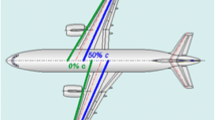Abstract
Supersonic transports are very drag sensitive. Technology to reduce drag by application of laminar flow, therefore, will be important; it is a prerequisite to achieve very long range capability. In earlier studies it was assumed that SCTs would only become possible by application of laminar flow [376]. But today, we request an SCT to be viable without application of laminar flow in order to maintain its competitiveness when laminar flow becomes available for subsonic and supersonic transports. By reducing fuel burned, laminar flow drag reduction reduces size and weight of the aircraft, or increases range capability -whereas otherwise size and weight would grow towards infinity. Transition mechanisms from laminar to turbulent state of the boundary layer flow (ALT, CFI, TSI) function as for transonic transports, but at more severe conditions: higher sweep angles, cooled surfaces; higher mode instabilities (HMI) must at least be taken into account, although they may not become important below Mach 3. Hitherto there is a worldwide lack of ground test facilities to investigate TSI at the expected cruise Mach numbers between 1.6 and 2.4; in Stuttgart, Germany one such facility -a Ludwieg tube- is still in the validation phase. A quiet Ludwieg tunnel could be a favourable choice for Europe. But it will require a new approach in designing aircraft which includes improved theoretical predictions, usage of classical wind tunnels for turbulent flow and flight tests for validation.
Access this chapter
Tax calculation will be finalised at checkout
Purchases are for personal use only
Preview
Unable to display preview. Download preview PDF.
Similar content being viewed by others
References
Mertens, J. Laminar Flow for Supersonic Transports in J. Szodruch (ed.): Proceedings of the First European Forum on Laminar Flow Technology. Hamburg, 16.-18.3.1992, DGLR-Report 92–06
Boeing Commercial Airplane Company Application of Laminar Flow Control to Supersonic Transport Configurations. NASA Contract Report 181917, July 1990
Stilla, J. Theoretische Transitionsvorhersage auf SCT-Tragflächen mit Überschallvorderkante. 9. DGLR-Fach-Symposium der AG STAB, 4.-7. Oktober 1994, Erlangen, DGLR-Report 94–04, pp. 210–215
Mack, L. Boundary-Layer Linear Stability Theory AGARD Report No. 709 “Special Course on Stability and Transition of Laminar Flow”, chap. 3, sub-chap. 9
Pfenninger, W. Flow Phenomena at the Leading Edge of Swept Wings. AGARDograph 97 on “Recent Developments in Boundary Layer Research”, Part IV, A. “Some Results from the X-2 lA Program, Part 1
Poll, D. I. A. Some Observations of the Transition Process on the Windward Face of a Long Yawed Cylinder. Journal of Fluid Mechanics 150 (1985), 329–356
Schrauf, G. Boundary Conditions for Compressible Linear Stability Theory. Brite-Euram Project 1051/1064 “Investigation of Supersonic Flow Phenomena”, Subtask 4. 4: Transition Prediction, Final Report, June 1992
Arnal, D. Boundary-Layer Transition: Predictions Based on Linear Theory. AGARD Report 793 “Special Course on Progress in Transition Modelling”, chap. 2
Bippes, H. Experiments on the Influence of Surface Curvature upon the Development of Streamwise vortices in an unstable threedimensional boundary-layer flow. Z. Flugwiss. Weltraumforsch. 19 (1995) 129–138
Herbert, Th. Parabolized Stability Equations. AGARD Report 793 “Special Course on Progress in Transition Modelling”, chap. 4
Schrauf, G., Herbert, Th., Stuckert, G. Evaluation of Transition in Flight Tests Using Nonlinear Parabolized Stability Equation Analysis Journal of Aircraft, 33, 3, May-June 1966, pp. 554–560
Herbert, Th., Schrauf, G. Crossflow-Dominated Transition in Flight Tests. AIAA-Paper 96–0185, 34th Aerospace Sciences Meeting zhaohuan Exhibit, January 15–18, 1996, Reno, NV, USA
Kleiser, L., Zang, T. Numerical Simulation of Transition in Wall-Bounded Shear Flows. Ann. Rev. Fluid Mech. 1991. 23: 495–537
Koppenwallner, G., Dorey, G. European Research and Testing Facilities Requested for Participation to SST/HST Projects. Proceedings of the European Symposium on Future Supersonic Hypersonic Transportation Systems, Strasbourg, 6–8 Nov. 1989, p. 306–316
Chen, F. J., Malik, M. R., Beckwith, L. E. Boundary-Layer Transition on a Cone and Flat Plate at Mach 3.5. AIAA Journal 27, 6 (June 1989), 687–693
Ludwieg, H., Hottner, H., Grauer-Carstensen, H. Der Rohrwindkanal der Aerodynamischen Versuchsanstalt Göttingen. Jahrbuch der DGLR 1969, p. 52–58
Krogmann, P. An experimental study of boundary layer transition on a slender cone at Mach 5. AGARD-CPP 224, Laminar-Turbulent-Transition, Lyngby, Denmark, 1977
Woan, C. J., Gingrich, P. B., George, M. W. CFD Validation of a Supersonic Laminar Flow Control Concept. AIAA-paper AIAA-91–0188, January 1991
Aviation Week and Space Technology, December 2, 1991, p. 17
Aviation Week and Space Technology, October 23, 1995, pp. 42–44
The Air Letter Experiment smoothes supersonic wing flow. The Air Letter No. 13,598, Monday, 14 October, 1996, p. 7
Author information
Authors and Affiliations
Editor information
Editors and Affiliations
Rights and permissions
Copyright information
© 1997 Springer-Verlag Wien
About this chapter
Cite this chapter
Mertens, J. (1997). Laminar Flow for Supersonic Transports. In: Sobieczky, H. (eds) New Design Concepts for High Speed Air Transport. International Centre for Mechanical Sciences, vol 366. Springer, Vienna. https://doi.org/10.1007/978-3-7091-2658-5_18
Download citation
DOI: https://doi.org/10.1007/978-3-7091-2658-5_18
Publisher Name: Springer, Vienna
Print ISBN: 978-3-211-82815-1
Online ISBN: 978-3-7091-2658-5
eBook Packages: Springer Book Archive




